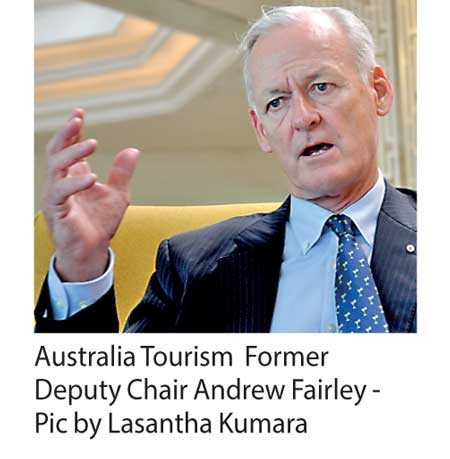Friday Dec 13, 2024
Friday Dec 13, 2024
Wednesday, 1 August 2018 00:00 - - {{hitsCtrl.values.hits}}

By Charumini de Silva
A top Australian tourism expert outlined that establishing ‘one voice’ for the industry would be a game changer for Sri Lanka, while highlighting key areas that need focus to stay ahead in the growing sector.
“Sri Lanka Tourism Strategic Plan 2017-2020 is an all-encompassing manifesto, but underpinning the success of any systemic reform is the implementation of an effective and efficient governance model. The Government has committed to the plan and it’s time that some brave decisions are taken to promote the destination with one voice,” Tourism Australia Former Deputy Chair Andrew Fairley said, addressing a public lecture in Colombo recently. The discussion, titled ‘Staying ahead in global tourism marketing: How core-market research and outreach can deliver a sustainable advantage’, was organised by the Australian High Commission and Sri Lanka Tourism Development Authority (SLTDA), facilitated by Australia’s Market Development Facility (MDF).
The key priority areas which Sri Lanka Tourism needs to attend to immediately, according to Fairley, were: fix governance, undertake research to inform positioning, maximise partnership with industry, and promote safety and security.
Fairley, who worked with the Government and tourism authorities on the Tourism Strategic Plan 2017-2020 (TSP) which was released last year, explored elements from the TSP, drawing parallels with Tourism Australia’s strategic journey, which began with consolidation.
Attributing how Australia decided to consolidate four separate bodies to establish ‘Tourism Australia’, he said that the structural and governance renovation was successful in marketing brand Australia as ‘one voice’, through proactive Government involvement, which enabled and enlivened the private sector.
Fairley also highlighted the importance of converting Sri Lanka’s plans into action, by conducting market research to fuel its tourism policies in the future. In the case of Australia, he noted that they carried out a detailed analysis of demand and supply in three of its biggest inbound tourism markets, including the UK, China and India, which led to the creation of Australia’s ‘experience pillars’, highlighting Australia’s strongest consumer assets.
“There are many niche opportunities in Sri Lanka as well, which are comprehensively identified in your tourism strategy. These include health and well-being, ecotourism, and the MICE market. The challenge is to determine which have priority. Success requires you to focus on a few core strategies and do them well,” he emphasised.
According to Fairley, understanding the requirement of each key market has allowed Australia to market different products in different tourism-generating countries.
He also said converting research findings into actual implementation involves marketing and communication outreach, which includes addressing the optimal distribution model and acknowledging the importance of agents, wholesalers and aggregators within the process.
Fairley said that Tourism Australia, together with other central and regional Government agencies and overseas offices, conduct research into every facet of tourism under a national tourism agenda, creating a reciprocal relationship, where policy drives research, which in turn drives policy.
“Despite there is a noteworthy budget involved in research activities, our return on investment to this is quite significant,” he added.
He said that the attractions the country markets shouldn’t be determined by the tourism authorities, but by the consumers, based on research. Furthermore, he said that promotional campaigns should be more reciprocal relationship rather than limiting to traditional methods of participating in expos.
Noting that a strong distribution network is vital, he stated their ‘Aussie Specialist’ travel agents platform has contributed immensely to the growth of their tourism industry, suggesting that Sri Lanka could also conduct a similar program.
While Sri Lankan authorities are pursuing numbers of tourist arrivals, with an aim of attracting over 4.2 million tourists by 2020, Fairley said that Australia Tourism has instead turned towards attracting higher revenue. Australia Tourism is given an annual promotional budget of AUD 150 million, to reach its 2020 goal of achieving between AUD 115 to 140 billion in annual revenue from AUD 65 billion in 2010.
He also drew on his experience in lifting industry standards and maintaining the sustainability of potentially fragile tourism destinations, which is a familiar theme in Sri Lanka, with popular hotspots like Yala National Park and Sigiriya facing challenges related to overcrowding and the consequent deterioration of the natural asset.
“Over-tourism is a somewhat awkward term, and describes the situation in which a particular destination exceeds its carrying capacity, either in physical or social terms. It results in a deterioration of the tourism experience for both visitors and locals, and if it continued unchecked, could cause serious brand damage,” he added.
He pointed out that establishing ‘one voice’ in tourism would also prevent any possible adverse impacts on the country’s tourism assets such as Yala and Sigiriya.